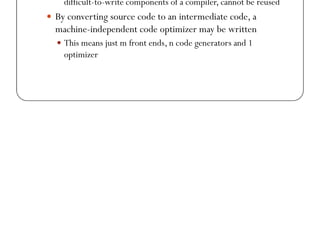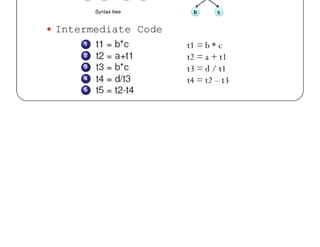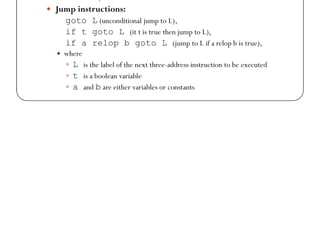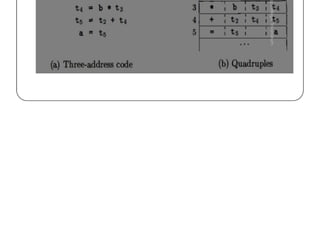Chapter 11 - Intermediate Code Generation.pdf
- 1. Dr. Shaukat Ali Chapter # 11 Inermediate Code Generation Dr. Shaukat Ali Department of Computer Science University of Peshawar
- 3. Introduction Intermediate code is the interface between front-end and back- end in a compiler Ideally the details of source language are confined to the front-end and the details of target machines to the back-end A source code can directly be translated into its target machine code Why at all we need to translate the source code into an intermediate code which is then translated to its target code?
- 4. Why Intermediate Code? If a compiler translates the source language to its target machine language without having the option for generating intermediate code, then for each new machine, a full native compiler is required Intermediate code eliminates the need of a new full compiler for every unique machine by keeping the analysis portion same for all every unique machine by keeping the analysis portion same for all the compilers The second part of compiler, synthesis, is changed according to the target machine It becomes easier to apply the source code modifications to improve code performance by applying code optimization techniques on the intermediate code
- 6. Why Intermediate Code? While generating machine code directly from source code is possible, it entails problems With m languages and n target machines, we need to write m front ends, m x n optimizers, and m x n code generators The code optimizer which is one of the largest and very- The code optimizer which is one of the largest and very- difficult-to-write components of a compiler, cannot be reused By converting source code to an intermediate code, a machine-independent code optimizer may be written This means just m front ends, n code generators and 1 optimizer
- 7. Intermediate Representation Intermediate codes can be represented in a variety of ways and they have their own benefits High Level IR - High-level intermediate code representation is very close to the source language itself.They can be easily generated from the source code and we can easily apply code modifications to enhance performance. But for target machine optimization, it is less enhance performance. But for target machine optimization, it is less preferred Low Level IR -This one is close to the target machine, which makes it suitable for register and memory allocation, instruction set selection, etc. It is good for machine-dependent optimizations Intermediate code can be either language specific (e.g., Byte Code for Java) or language independent (three-address code).
- 8. Intermediate Code Generation Intermediate code must be easy to produce and easy to translate to machine code A sort of universal assembly language Should not contain any machine-specific parameters (registers, addresses, etc.) Intermediate code is represented in three-address space but the Intermediate code is represented in three-address space but the type of intermediate code implementation is based on the compiler designer Quadruples, triples, indirect triples are the classical forms used for machine-independent optimizations and machine code generation Static SingleAssignment form (SSA) is a recent form and enables more effective optimizations
- 9. Three-Address Code Instructions are very simple : LHS is the target and the RHS has at most two sources and one operator RHS sources can be either variables or constants Examples: a = b + c, x = -y, if a > b Examples: a = b + c, x = -y, if a > b goto L1 Three-address code is a generic form and can be implemented as quadruples, triples, indirect triples Example:The three-address code for (a+b*c)- (d/(b*c)) is below
- 10. IR Code is Made From (a+b*c)- (d/(b*c)) Intermediate Code t1 = b * c t2 = a + t1 t3 = d / t1 t4 = t2 – t3
- 11. Example The intermediate code produced from DAG is more compact as compared AST a = b * (minus c) + b * (minus c)
- 12. Instructions in 3 – Address Space (1) Assignment instructions: a = b biop c, a = uop b, and a = b (copy) Where biop is any binary arithmetic, logical, or relational operator uop is any unary arithmetic (++, --, conversion) or logical operator (!) Conversion operators are useful for converting integers to floating point numbers, etc. numbers, etc. Jump instructions: goto L (unconditional jump to L), if t goto L (it t is true then jump to L), if a relop b goto L (jump to L if a relop b is true), where L is the label of the next three-address instruction to be executed t is a boolean variable a and b are either variables or constants
- 13. Instructions in 3 – Address Space (2) Functions: func begin <name> (beginning of the function), func end (end of a function), param p (place a value parameter p on stack), refparam p (place a reference parameter p on stack), call f, n (call a function f with n parameters), call f, n (call a function f with n parameters), return (return from a function), return a (return from a function with a value a) Indexed copy instructions: a = b[i] (a is set to contents(baseaddress(b)+offset(i)), where b is (usually) the base address of an array a[i] = b (ith location of array a is set to b)
- 14. Instructions in 3 – Address Space (3) Pointer assignments: a = &b (a is set to the address of b, i.e., a points to b) *a = b (contents(contents(a)) is set to contents(b)) a = *b (a is set to contents(contents(b)))
- 15. Intermediate Code – Example 1
- 16. Intermediate Code – Example 2
- 17. Intermediate Code – Example 3
- 18. Intermediate Code – Example 4
- 19. Intermediate Code – Example 5
- 20. Data Structures for 3 – Address Code Quadruples Has four fields: op, arg1, arg2 and result Temporaries are used Triples Temporaries are not used and instead references to instructions Temporaries are not used and instead references to instructions are made Indirect triples In addition to triples we use a list of pointers to triples
- 21. Quadruples In quadruples representation, there are four fields for each instruction: op, arg1, arg2, result Binary ops have the obvious representation Unary ops do not use arg2 Operators like param does not use either arg2 result Operators like param does not use either arg2 result Jumps put the target label into the result The quadruples implement the three address space for the expression a = b * (-c) + b * (-c)
- 22. Quadruples
- 23. Triples Triples has only three fields for each instruction: op, arg1, arg2 The result of an operation x op y is referred by its position Triples are equivlant to signature of nodes in DAG or syntax tree tree Triples and DAG are equivalent representations only for expressions Ternary operation like X[i] =Y requires two entries in the triple structure; similarly forY = X[i]
- 24. Triples
- 25. Indirect Triples These consist of a listing of pointers to triples; rather than a listing of the triples themselves The triples consists of three fields: op, arg1, arg2 The arg1 or arg2 could be pointers
- 26. Example a = b * (minus c) + b * (minus c) t1 = minus c t2 = b * t1 t3 = minus c t4 = b * t3 t5 = t2 + t4 a = t5 Three address code minus * minus c t3 * + = c t1 b t2 t1 b t4 t3 t2 t5 t4 t5 a arg1 result arg2 op Quadruples minus * minus c * + = c b (0) b (2) (1) (3) a arg1 arg2 op Triples (4) 0 1 2 3 4 5 minus * minus c * + = c b (0) b (2) (1) (3) a arg1 arg2 op IndirectTriples (4) 0 1 2 3 4 5 (0) (1) (2) (3) (4) (5) op 35 36 37 38 39 40
- 27. Example 2
- 28. End of Chapter # 11












![Instructions in 3 – Address Space (2)
Functions:
func begin <name> (beginning of the function),
func end (end of a function),
param p (place a value parameter p on stack),
refparam p (place a reference parameter p on stack),
call f, n (call a function f with n parameters),
call f, n (call a function f with n parameters),
return (return from a function),
return a (return from a function with a value a)
Indexed copy instructions:
a = b[i] (a is set to contents(baseaddress(b)+offset(i)),
where b is (usually) the base address of an array
a[i] = b (ith location of array a is set to b)](https://image.slidesharecdn.com/chapter11-intermediatecodegeneration-230723144054-2ab90b6b/85/Chapter-11-Intermediate-Code-Generation-pdf-13-320.jpg)









![Triples
Triples has only three fields for each instruction: op, arg1,
arg2
The result of an operation x op y is referred by its position
Triples are equivlant to signature of nodes in DAG or syntax
tree
tree
Triples and DAG are equivalent representations only for
expressions
Ternary operation like X[i] =Y requires two entries in the
triple structure; similarly forY = X[i]](https://image.slidesharecdn.com/chapter11-intermediatecodegeneration-230723144054-2ab90b6b/85/Chapter-11-Intermediate-Code-Generation-pdf-23-320.jpg)




